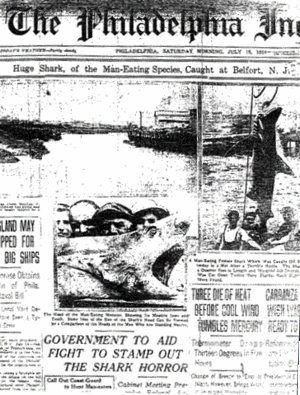Jersey Shore shark attacks of 1916
The Jersey Shore shark attacks of 1916 were a series of brutal shark attacks along the coast of New Jersey between July 1 and July 12, 1916. Four people were killed and one gravely injured. The attacks left the world in shock and sharks stereotyped as bloodthirsty killers.

Since 1916, scholars have debated which shark species was responsible and the number of animals involved. The Great white shark and the Bull shark are mostly thought to be the shark species being blamed for the attack. The attacks happened during a deadly summer heat wave and polio epidemic in the Northeastern United States. It drove thousands of people to the seaside resorts of the Jersey Shore.
The shark attack led many meetings about public awareness in congress by the United States House of Representatives and by President of the United States Woodrow Wilson.
Shark attacks on the Atlantic Coast of the United States outside the semitropical states of Florida, Georgia, and the Carolinas were rare, but scholars believe that the increased presence of sharks and humans in the water led to the attacks in 1916.
Sharks have ever since been hunted and overfished.
Timeline: July 1st, 1916, as he takes a afternoon swim, 25 year old Charles Vansant's leg is almost torn off by a shark. He is escorted from the water and dies a little later as he resides in Engleside Hotel. 5 days later Charles Bruder is out swimming far from the shore. His legs are torn off and he dies from shock and blood loss in a hospital.